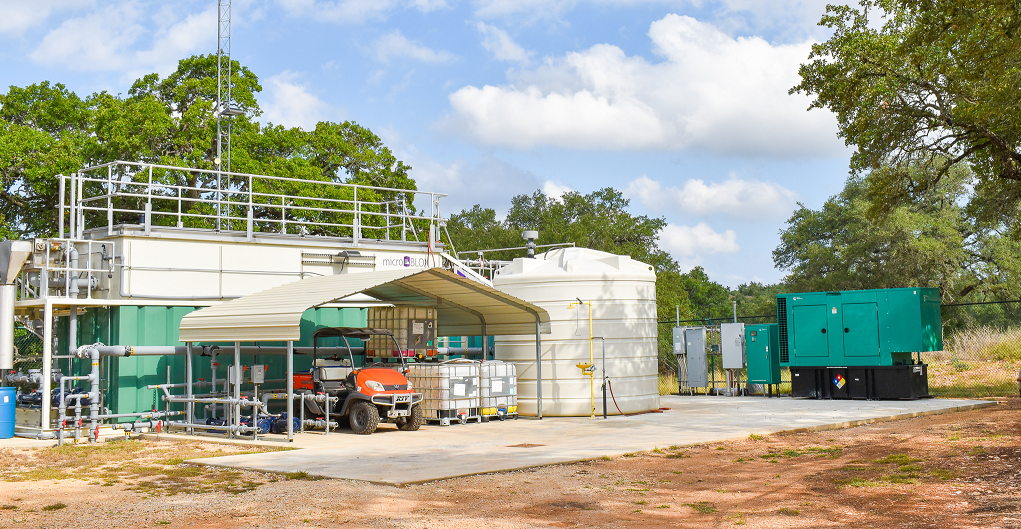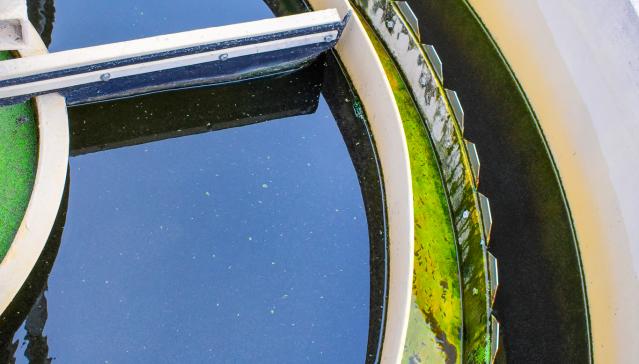Texas Water Co treats wastewater in addition to drinking water. Multiple regulations and standards are implemented to ensure the proper production of effluent.
Find information on the sludge treatment process and the water quality of wastewater.
Texas Water Co operates four wastewater treatment plants (WWTPs) around the Canyon Lake area. The HEB WWTP is located in the City of Bulverde and treats influent from the nearby HEB plus! and surrounding retail stores. The Grove WWTP treats influent from the Vintage Oaks - The Grove subdivision. The River Crossing Carriage House WWTP (RCCH WWTP) treats influent from the nearby subdivision River Crossing. These three treatment plants follow a permit granted by the state for WWTP.

Image: The Grove WWTP
Each facility was designed to treat the characteristics of the influent coming through the WWTF, therefore, the type of treatment differs slightly at all three. The HEB WWTF consists of an activated sludge process using extended aeration. The Grove WWTF also uses an activated sludge process but utilizes a membrane bioreactor system. The RCCH WWTF uses a combination of both these processes. Because the treatment processes are different, the way in which we perform quality assurance sampling is also different at each site.
The table below includes some of the state-required constituents we monitor on a weekly or daily basis and the standards Texas Water Co must meet. Typically, each plant will remove about 95% to 99% of contaminants in the wastewater.
|
Treatment Facility |
BOD5/CBOD5 (mg/l) |
TSS (mg/l) |
Turbidity (mg/l) |
E.Coli (mg/l) |
Ammonia-Nitrogen (mg/l) |
Total Phosphorus (mg/l) |
|
HEB WWTF |
5 |
5 |
3 |
20 |
N/A |
N/A |
|
The Grove WWTF |
5 |
5 |
N/A |
126 |
2 |
1 |
|
RCCH WWTF |
20 |
20 |
N/A |
N/A |
N/A |
N/A |
*Concentrations are based on a daily average within a period of one calendar month
When wastewater is treated, it results in two by-products: effluent and sludge. The effluent, or treated water, is applied on approved irrigation fields. Every year, Texas Water Co takes a soil sample from the effluent irrigation field and reports the results to the state. In an effort to promote water conservation, The Texas Water Co uses effluent to irrigate at the River Crossing Golf Club, Startzville Elementary School, and its office located on Sattler Rd. Texas Water Co is working on approval to use effluent water for irrigation methods and other outdoor use throughout the service area.
The sludge is held in a holding tank. When the holding tank reaches a certain capacity, it is hauled to a special landfill that will properly treat the sludge for disposal. Every year, Texas Water Co reports the amount of sludge produced at each WWTF to the TCEQ. Below is a table with the amount of sludge produced in the previous reporting period. Once during the life of the WWTF permit, Texas Water Co reports the concentration of pollutants found in the sludge. The permit is currently valid for 10 years before a renewal application is required. The sludge is tested for multiple metals. A list of these metals can be found in the table below. For a detailed list of constituents, contact Texas Water Co at (830)312-4600 or customerservice@txwaterco.com.
|
WWTF |
Sludge Produced (Sept 2020 to Aug 2021) |
|
HEB WWTF |
0.3506 dry tons |
|
The Grove WWTF |
3.5556 dry tons |
|
RCCH WWTF |
0.60154 dry tons |
|
Metals Sampled for in Sludge |
Max Concentration (mg/kg) |
|
Arsenic |
75 |
|
Cadmium |
85 |
|
Chromium |
3,000 |
|
Copper |
4,300 |
|
Lead |
840 |
|
Mercury |
57 |
|
Molydbenum |
75 |
|
Nickle |
420 |
|
PCBs |
49 |
|
Selenium |
100 |
|
Zinc |
7,500 |
